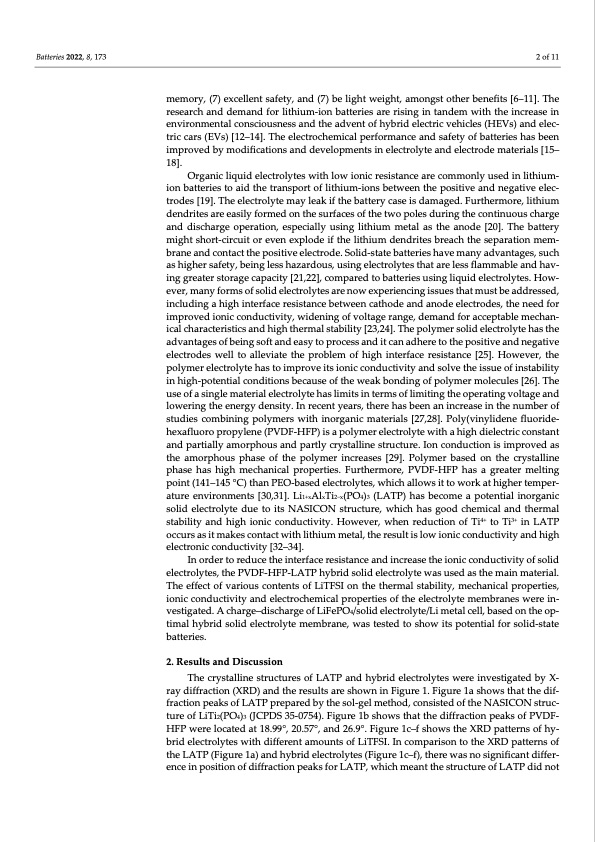
PDF Publication Title:
Text from PDF Page: 002
Batteries 2022, 8, 173 2 of 11 memory, (7) excellent safety, and (7) be light weight, amongst other benefits [6–11]. The research and demand for lithium-ion batteries are rising in tandem with the increase in environmental consciousness and the advent of hybrid electric vehicles (HEVs) and elec- tric cars (EVs) [12–14]. The electrochemical performance and safety of batteries has been improved by modifications and developments in electrolyte and electrode materials [15– 18]. Organic liquid electrolytes with low ionic resistance are commonly used in lithium- ion batteries to aid the transport of lithium-ions between the positive and negative elec- trodes [19]. The electrolyte may leak if the battery case is damaged. Furthermore, lithium dendrites are easily formed on the surfaces of the two poles during the continuous charge and discharge operation, especially using lithium metal as the anode [20]. The battery might short-circuit or even explode if the lithium dendrites breach the separation mem- brane and contact the positive electrode. Solid-state batteries have many advantages, such as higher safety, being less hazardous, using electrolytes that are less flammable and hav- ing greater storage capacity [21,22], compared to batteries using liquid electrolytes. How- ever, many forms of solid electrolytes are now experiencing issues that must be addressed, including a high interface resistance between cathode and anode electrodes, the need for improved ionic conductivity, widening of voltage range, demand for acceptable mechan- ical characteristics and high thermal stability [23,24]. The polymer solid electrolyte has the advantages of being soft and easy to process and it can adhere to the positive and negative electrodes well to alleviate the problem of high interface resistance [25]. However, the polymer electrolyte has to improve its ionic conductivity and solve the issue of instability in high-potential conditions because of the weak bonding of polymer molecules [26]. The use of a single material electrolyte has limits in terms of limiting the operating voltage and lowering the energy density. In recent years, there has been an increase in the number of studies combining polymers with inorganic materials [27,28]. Poly(vinylidene fluoride- hexafluoro propylene (PVDF-HFP) is a polymer electrolyte with a high dielectric constant and partially amorphous and partly crystalline structure. Ion conduction is improved as the amorphous phase of the polymer increases [29]. Polymer based on the crystalline phase has high mechanical properties. Furthermore, PVDF-HFP has a greater melting point (141–145 °C) than PEO-based electrolytes, which allows it to work at higher temper- ature environments [30,31]. Li1+xAlxTi2−x(PO4)3 (LATP) has become a potential inorganic solid electrolyte due to its NASICON structure, which has good chemical and thermal stability and high ionic conductivity. However, when reduction of Ti4+ to Ti3+ in LATP occurs as it makes contact with lithium metal, the result is low ionic conductivity and high electronic conductivity [32–34]. In order to reduce the interface resistance and increase the ionic conductivity of solid electrolytes, the PVDF-HFP-LATP hybrid solid electrolyte was used as the main material. The effect of various contents of LiTFSI on the thermal stability, mechanical properties, ionic conductivity and electrochemical properties of the electrolyte membranes were in- vestigated. A charge–discharge of LiFePO4/solid electrolyte/Li metal cell, based on the op- timal hybrid solid electrolyte membrane, was tested to show its potential for solid-state batteries. 2. Results and Discussion The crystalline structures of LATP and hybrid electrolytes were investigated by X- ray diffraction (XRD) and the results are shown in Figure 1. Figure 1a shows that the dif- fraction peaks of LATP prepared by the sol-gel method, consisted of the NASICON struc- ture of LiTi2(PO4)3 (JCPDS 35-0754). Figure 1b shows that the diffraction peaks of PVDF- HFP were located at 18.99°, 20.57°, and 26.9°. Figure 1c–f shows the XRD patterns of hy- brid electrolytes with different amounts of LiTFSI. In comparison to the XRD patterns of the LATP (Figure 1a) and hybrid electrolytes (Figure 1c–f), there was no significant differ- ence in position of diffraction peaks for LATP, which meant the structure of LATP did notPDF Image | Lithium Salt Concentration on Materials

PDF Search Title:
Lithium Salt Concentration on MaterialsOriginal File Name Searched:
batteries-08-00173.pdfDIY PDF Search: Google It | Yahoo | Bing
Product and Development Focus for Salgenx
Redox Flow Battery Technology: With the advent of the new USA tax credits for producing and selling batteries ($35/kW) we are focussing on a simple flow battery using shipping containers as the modular electrolyte storage units with tax credits up to $140,000 per system. Our main focus is on the salt battery. This battery can be used for both thermal and electrical storage applications. We call it the Cogeneration Battery or Cogen Battery. One project is converting salt (brine) based water conditioners to simultaneously produce power. In addition, there are many opportunities to extract Lithium from brine (salt lakes, groundwater, and producer water).Salt water or brine are huge sources for lithium. Most of the worlds lithium is acquired from a brine source. It's even in seawater in a low concentration. Brine is also a byproduct of huge powerplants, which can now use that as an electrolyte and a huge flow battery (which allows storage at the source).We welcome any business and equipment inquiries, as well as licensing our flow battery manufacturing.| CONTACT TEL: 608-238-6001 Email: greg@salgenx.com | RSS | AMP |